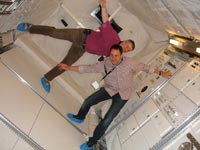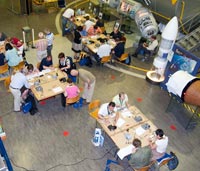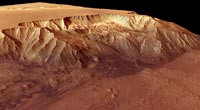Teachers fly high at the European Space Agency Inspire article
Eleanor Hayes reports on the recent teacher workshop at the European Space Research and Technology Centre.

(left) and Javier Mendez
inside a replica of the
Columbus module of the
International Space Station
Image courtesy of Carmen
Guerra
In June 2010, I was delighted to be invited to take part in the European Space Agency’s first human spaceflight teacher workshop at the European Space Research and Technology Centre (ESTEC) in the Netherlands. Not only did I enjoy the contact with many enthusiastic European science teachers – the target audience of Science in School – but I was able to take part in some fascinating workshops.
‘What are the obstacles to Martian exploration?’ asked Anupam Ojha, physics teacher and director of education at the UK’s National Space Centre. He asked us to consider the best route from Earth to Mars (not the shortest one) and what the many challenges of the Martian environment are. Did you know, for example, that at the very low atmospheric pressure on Mars, your blood would boil instantly at well below body temperature? Or that the force of the air rushing out of your lungs could knock your front teeth out? No wonder Mars explorers will need space suits!

radios
Image courtesy of Anneke Le
Floc’h / ESA
Over the course of 90 minutes, Anu took us on a dizzying tour of the interplanetary and Martian environment – with the aid of hypodermic syringes, marshmallows, liquid nitrogen, an orange and other basic materials. The emphasis of his workshop was to show how the topic of space can be used to teach science. At the end of the day, each teacher received a memory stick full of pictures, teaching ideas and other useful resources.
In the neighbouring room, a further group of 20 teachers was learning how to assemble a radio – and receive signals from local radio stations. “This is the first time I had ever soldered anything before!” commented several of the teachers.

the huge Valles Marineris
rift valley on Mars
Image courtesy of ESA / DLR /
FU Berlin (G Neukum)
Later that afternoon, a panel led an animated discussion about how to use students’ enthusiasm for space to engage them in science lessons. One of the outcomes of the discussion was a new thread in the Science in School online forumw1 – in which teachers can share their space-related teaching materials with other Science in School readers.
Later, the teachers met one of ESA’s astronauts, Frank De Winne, who described some of the highlights of his OasISS mission as well as his role in the educational projects on the International Space Station (ISS). Being able to talk to Frank informally and ask questions about his work was one of the high points of the workshop.
For both the teachers and ESA, the workshop was a big success – and there will be another one in Summer 2011. Why not apply to participate? Keep watching the ESA Human Spaceflight websitew2 for details.
Listening to teachers
Shamim Hartevelt-Velani explains why ESA values the involvement of teachers.
In my work – as a teacher working in the human spaceflight education department at ESA – it has always been important to listen to what teachers want. This workshop was one such opportunity, when we brought together 40 enthusiastic teachers from 18 member states of ESA. Not only did we immerse them in three days of hands-on activities, we also introduced them to some of the education materials that we have developed at ESA, and discussed how they could be used in the classroom.
The teachers were able to provide us with useful feedback on some of the educational resources such as the DVD Feeding our Future – Nutrition on Earth and in Spacew3, the educational game ‘Spaceflight Challenger 1’w4 and the competition ‘Take your classroom into space’ (see Patterson, 2009).
During the workshop, the teachers also suggested possible future demonstrations and experiments that could be done on the International Space Station by the astronauts, similar to the outcome of the ‘Take your classroom into space’ competition – which was very successful in engaging students and teachers from all over Europe. We’re even investigating how the students themselves can get involved in future: carrying out space experiments in short educational films.
The feedback we continue to receive from our workshop participants and other teachers helps us to improve our materials and gives us new ideas about what teachers need to assist them in making science teaching more innovative and interesting to students. It also illustrates that the workshop was the exciting beginning of an iterative process of sharing and collaboration between teachers and the ESA human spaceflight education group.
References
- Patterson L (2009) A classroom in space. Science in School 12: 50-54. www.scienceinschool.org/2009/issue12/spaceclassroom
- To find out more about the ‘Take your classroom into space’ competition, see: www.esa.int or use the direct link: http://tinyurl.com/2cpk4sq
- The ‘Take your classroom into space’ education kit can be ordered online here: http://www.esa.int/Our_Activities/Human_Spaceflight/Education/Take_your_classroom_into_space
Web References
- w1 – To join the discussion about how to use space to teach science, visit the Science in School discussion forum: www.scienceinschool.org/forum/esahs
- w2 – To find out when the next teacher workshop will be, and to learn about the wealth of materials developed by the ESA Human Spaceflight education department, see: www.esa.int/esaHS/education.html
- For details of many more education materials produced by ESA, see www.esa.int/educationmaterials
- All education materials produced by ESA are freely available to teachers in the 18 ESA member states. Many are translated into several European languages.
- w3 – Feeding our Future – Nutrition on Earth and in Space examines food as a vital part of life on Earth and in space. To order a free DVD or download the video (available with subtitles in 13 European languages), see: www.esa.int or use the direct link: http://tinyurl.com/262fl52
- w4 – Become an astronaut on the International Space Station. ‘Spaceflight Challenge 1’ features science topics from across European secondary-school curricula. To find out more about this role-playing game, see: www.esa.int or use the direct link: http://tinyurl.com/39tvgsy
Resources
- Below is a selection of space-related articles previously published in Science in School.
- Hartevelt-Velani S, Walker C, Elmann-Larsen B (2008) The International Space Station: life in space. Science in School 10: 76-81 www.scienceinschool.org/2008/issue10/iss
- Hartevelt-Velani S, Walker C (2008) The International Space Station: a foothold in space. Science in School 9: 62-65. www.scienceinschool.org/2008/issue9/iss
- Wegener A-L (2008) Laboratory in space: interview with Bernardo Patti. Science in School 8: 8-12. www.scienceinschool.org/2008/issue8/bernardopatti
- Williams A (2008) The Automated Transfer Vehicle – supporting Europe in space. Science in School 8: 14-20. www.scienceinschool.org/2008/issue8/atv
- Warmbein B (2007) Down to Earth: interview with Thomas Reiter. Science in School 5: 19-23. www.scienceinschool.org/2007/issue5/thomasreiter





